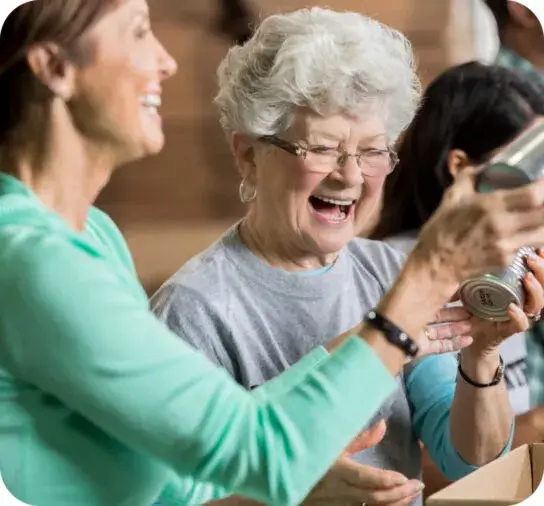The guidance you need for the care they deserve
Find senior living near you
We are the local partner you can trust For one of the most important decisions you’ll ever make
Exploring senior living options can be confusing and time-consuming.
Assisted Living Locators® Care Advisors are in your community and work closely with you to guide you through the process from beginning to end—answering your questions and addressing your concerns, helping you feel confident and comfortable with your decisions.

Family Testimonials
I enjoyed working with Tara and Assisted Living Locators immensely. It was great to speak to someone in the medical field while going through this process for my parents. And the fact it was free for us was amazing!
We are so grateful for Adriene's help! She worked to find our parents the perfect community that met both their needs and budget. I would highly recommend Adriene to anyone looking for senior housing.
Rick was extremely helpful to me finding a facility for my grandmother that met her needs and budget. He toured facilities with me, presented relevant details, and asked questions to the staff I didn't think of that helped me evaluate the facility much more effectively.
Why Assisted Living Locators®?

We’re your partner, not just a placement agent
Deciding when, how, and where to place your loved one in a senior living home or community can be overwhelming. Assisted Living Locators® is here to guide you and simplify the process. We’re committed to helping you find the right solution for now and the future.

We work with you at a local level
Our advisors live and work in your community. We are experts with the care options in your area. Once we understand your needs, we’ll create a customized plan to match, tour communities with you to help you find the best choice, and help guide you through every step of the decision-making process.

Unbiased solutions at no cost to you
Our only obligation is to you – and making sure that we help you find the best solution for your needs. You can depend on us to make finding care as simple and quick as possible.
Over 100,000
number of helped families in 2023
Matchmaking seniors with caring providers for over two decades.

What Type of Housing or Care Do You Need?
It’s hard to know what the right fit might be with the wide range of senior living and in-home care options available.
Here, you can explore them all.

Explore Here
-Or-
About Senior Living

Assisted Living

Memory Care

Senior Living
Take our senior care assessment to help you understand more about the appropriate care needs for your loved one.
- Type of housing
- Level of care
- Additional services available
Start Your Senior Living Search
Our national network of local experts are in your community and ready to help you:
- Simplify your search
- Understand the options
- Compare costs and services
- Provide unbiased, personal, and expert guidance
- Make the best senior care choices for your loved ones
Certified Advisors

Marcus & Chrissy Moser
Serving S. Fort Myers, Naples, Marco Island, and Southwest Florida
Aging in place is one of the greatest gifts we can give our loved ones. Let us assist you with finding the perfect home for you or your loved one during this often challenging life transition. With over 10 years experience placing loved ones with caring providers, we’ll be there to hold your hand every step of the way. From discussing levels of care, touring facilities, and providing support on move-in day, we ensure a smooth transition to your forever home.

Bill Thompson
Serving the Greater Richmond Region, including Henrico, Chesterfield and Hanover Counties in Central Virginia
At Assisted Living Locators, we guide you and your family through what can be a confusing and trying process. First, we meet to determine what communities are a good fit for you. I assess your needs based upon care requirements, socialization, location preference and budget. I represent most of the quality, licensed communities in the Greater Richmond Virginia area, which allows me to offer several excellent options. You can count on me to be with you every step of the way in the decision-making process.

Beau Herman and David Hopkins
Serving in Orlando, Conway, Belle Isle, Union Park, Winter Park, Maitland, Oviedo, Sanford, Alafaya, Altamonte Springs, Casselberry, Longwood, Winter Springs, Chuluota, Christmas, Eustis, Zellwood, Apopka, Lake Mary, Orange City, Deltona, DeBary, DeLand
Meet Your Central Florida Senior Care Team Beau Herman | David Hopkins Owners – Assisted Living Locators Central Florida Compassionate Guidance from People Who’ve Walked the Journey Themselves At Assisted Living Locators, we believe no one should face senior care decisions alone. That belief unites Beau Herman and David Hopkins, owners of Assisted Living Locators of Central Florida. Together, they serve families across the region with empathy, experience, and expert guidance—at no cost. Beau Herman Beau spent 15 years as a leader at Disney before transitioning to vacation sales and then eventually senior care. Beau holds Certified Senior Advisor (CSA) and Certified Dementia Practitioner (CDP) certifications as well as an undergraduate degree from The University of Mississippi and masters’ degrees from Florida State University and Rollins College. Beau’s senior care journey began with a personal family crisis involving his wife, Mercer’s grandmother. After watching a loved one struggle through the transition from independent living to assisted care, they knew families deserved better support, compassionate, informed, and free of financial burden. That calling led them to Assisted Living Locators. Beau has long been a lover of nature and tries to find the natural order in everything, which is why he participates in the Assisted Living Locators’ Feed the Birds, Help the Seniors Program, One Tree Planted, and partners with his therapy bunny, Biggie Bunny, to help spread joy to seniors. Beau also started Senior Chef Showdown Inc., a 501c3 non-profit organization that uses the culinary expertise of chefs at senior living communities to help Central Florida seniors in need. David Hopkins David brings over 20 years of healthcare experience, including 10 years as an Executive Director in senior living communities. His leadership is shaped by personal caregiving—having walked alongside five family members through hospital stays, assisted living, long-term care, dementia care, hospice, and end-of-life decisions. In addition to being a Certified Dementia Practitioner, David is a former leader with The Walt Disney Company, where he honed his commitment to excellence, service, and personal connection. He leads with faith and believes that every step in the senior care journey deserves dignity, love, and support. David and his wife Alison have been married for 25 years and are proud parents to two children, Nick and Cate. He’s also the devoted dog dad and chief walker of Tango and Marty. “We are all on a journey; you do not have to go it alone.” Serving You with Purpose and Heart Whether you’re just starting to explore care options or facing an urgent decision, Beau and David are here to help. Their combined knowledge and personal passion ensure that every family they serve is treated with respect, clarity, and care. Contact us today to start your journey with trusted, local guidance—at no cost to you.
Looking for senior living properties?
Find senior living near you
or Call now
